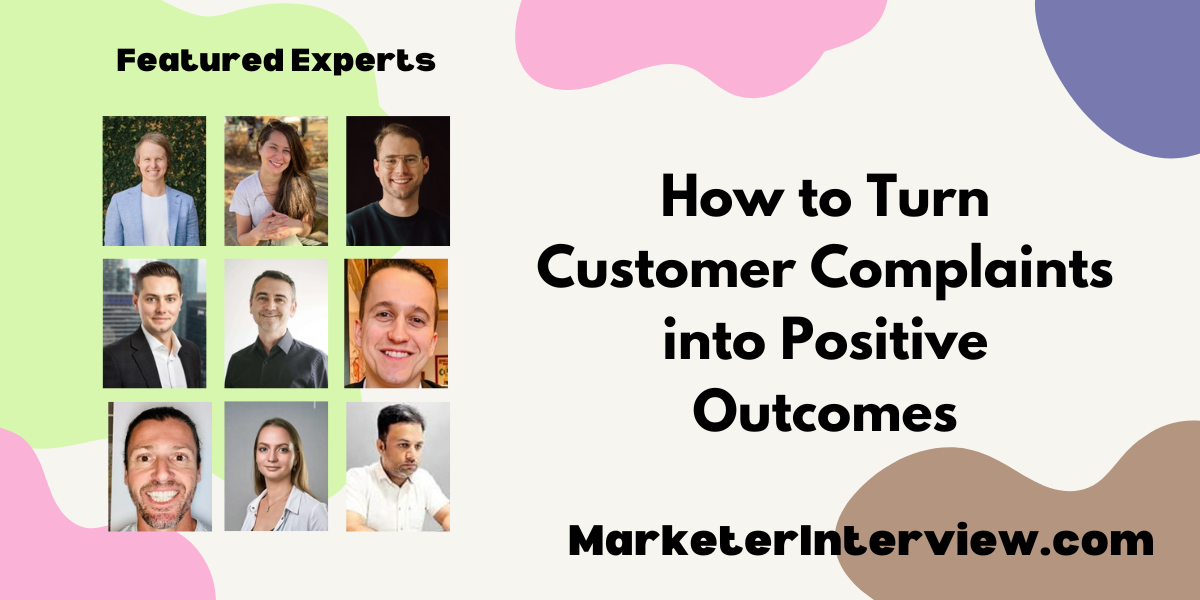How to Turn Customer Complaints into Positive Outcomes
Turning customer complaints into triumphs is an art, and to give you a masterclass, we’ve compiled insights from CEOs and founders. From resolving issues with transparency to transforming complaints into support successes, explore the eight transformative strategies these leaders have successfully employed.
Want to get quoted in MarketerInterview.com content just like this? Apply to become a contributor today!
Contents
- 1 Resolve Issues with Transparency
- 2 Leverage Feedback to Improve Service
- 3 Collaborate for Competitive Compensation
- 4 Adapt Solutions to Customer Challenges
- 5 Discounts Can Build Advocacy
- 6 Turn Critics into Brand Champions
- 7 Exceed Expectations with Customized Service
- 8 Impress with Swift Issue Rectification
- 9 Transform Complaints into Support Successes
Resolve Issues with Transparency
One way that I was able to turn a customer complaint into a positive outcome was when I had to cancel a purchase contract with a seller who had reached out to us through our website. In this particular case, the property was under contract for a little bit too high, and so we had to back out of the deal, and the seller was very upset.
The seller threatened that they would go to the Better Business Bureau and post on social media about the incident. In order to navigate this and still make sure that the seller was helped, I walked them through all of the numbers on the deal and showed them how the renovation budget would be much higher. The seller didn’t agree to a price reduction, and so what we had to do was find another way to help them so that we would avoid the potential chaos. We ended up connecting them with a local real estate agent that we use, who was able to list the property for them and get them exactly what they needed in a timely manner.
By doing this, we were able to show that we were still willing to solve their problem, we were able to get a marketing fee for ourselves from the agent so that we could still monetize the lead, and we were able to stop a potential chaotic situation from developing. My biggest takeaways from this were that I need to be more conservative with my offers to sellers so that I’m able to truly follow through on the initial offer rather than offer higher just to get a contract.

Sebastian Jania, CEO, Ontario Property Buyers
Leverage Feedback to Improve Service
In one of our digital marketing campaigns at Omniconvert, we applied customer segmentation to target users based on their browsing behavior on our website. Specifically, we divided visitors into segments based on the products they showed interest in and how deeply they delved into the product information sections.
For one segment particularly interested in our personalization tools, we crafted tailored email campaigns that highlighted features relevant to their interests. The results were a significant uptick in engagement with our emails, leading to a 25% increase in conversions from this segment. This approach underscored the effectiveness of tailoring communication to meet the specific needs of different customer groups.
Regarding turning a customer complaint into a positive outcome, there was an instance where a client expressed dissatisfaction with the response time of our support team. By addressing the issue directly, not only were we able to resolve the client’s immediate problem by prioritizing their request, but we also took this feedback as an opportunity to overhaul our customer service processes. We implemented a more dynamic ticketing system that ensured quicker response times. The client appreciated the swift and thorough resolution, which transformed their initial dissatisfaction into a positive view of our commitment to customer service.
This experience taught me the value of feedback in identifying areas for improvement and the importance of quick, effective responses to customer concerns.

Valentin Radu, CEO & Founder, Blogger, Speaker, Podcaster, Omniconvert
Collaborate for Competitive Compensation
In the recruiting industry, complaints aren’t unusual. What was a great hire six months ago might burn out quickly, and companies think it’s always our fault.
While retention rates are a key measure of success, we don’t have a crystal ball, and I used to get frustrated at these complaints.
That was, until I realized it was an opportunity.
Recently, a company came to me frustrated over a placement I’d handled months ago. The executive had job-hopped when a better opportunity came up, and they’d lost him. The thing was: I wasn’t surprised. Their benefits package and salary weren’t competitive in a growing market.
So I carefully broached this topic with them and was pleased to hear they’d been thinking the same thing. We worked together to come up with a better package by studying their competitors, and the result was a workforce with increased loyalty.
I’d been nervous for no reason: they didn’t think I was shifting the blame, so much as identifying the problem. This helped me realize that as long as you have an actionable solution to the problem, it doesn’t matter who made the mistake.

Travis Hann, Partner, Pender & Howe
Adapt Solutions to Customer Challenges
Our customer service team is directed to accept customer complaints as a vital means of building our business. We know that each customer is unique; however, often their issue or challenge can carry over to other customer experiences in the future. Thus, we listen and learn, and that is exactly what happened during a recent customer complaint event.
This customer represented a firm that sought to produce video-playing books highlighting their business service. The customer mistakenly delayed the production decisions that required her internal approvals for us to commence production.
Apparently, the customer did not understand the required lead time for a custom order of their design. Our team was able to reply with several alternative selections, literally creating a custom product from our in-stock inventory. This customer was delighted, and our team gained yet another opportunity to see how our flexibility, coupled with a rather broad understanding of our product’s reach, can produce a successful outcome.

Ashley Kenny, Co-Founder, Heirloom Video Books
Discounts Can Build Advocacy
One time, a customer complained about a bug in our software that was causing them major headaches. Instead of getting defensive, we immediately jumped into action, fixed the issue, and offered them a discount on their next purchase as a gesture of goodwill.
The customer was so impressed by our quick response and willingness to make things right that they not only continued using our software but also referred us to several of their colleagues. The key takeaway from this experience was that turning a negative situation into a positive one can not only retain a customer but also turn them into a loyal advocate for your brand.

Alex Stasiak, CEO & Founder, Startup House
Turn Critics into Brand Champions
Absolutely. Had a customer vent on social media about a flawed product. Instead of shying away, we saw an opportunity. Engaged directly, publicly solved their issue, replaced the item, and added a bonus as a goodwill gesture.
The customer’s frustration turned into brand love. They shared their positive experience widely, becoming an advocate for us.
Key takeaways? Quick, genuine responses are powerful. Never hide from criticism. Embrace it, solve it, and you can turn critics into champions. Transparency builds trust. Open dialogue is gold in digital marketing. And always exceed expectations—that’s where loyalty is born.

Casey Jones, Founder, Head of Marketing, CJ&CO
Exceed Expectations with Customized Service
I will never forget one of my most successful cases concerning consumer discontent with our equipment. Instead of addressing the issue earlier, we actively listened to the customers’ complaints and understood what they experienced. We handled the matter with appropriate speed and offered customized service, which surpassed their expectations.
This prevention philosophy resolved the complaint and transformed the customer into a loyal brand advocate. The vital thing was listening to the customers’ needs and objections and responding quickly to avoid dissatisfaction with the services provided.

Fahad Khan, Digital Marketing Manager, Ubuy India
Impress with Swift Issue Rectification
One memorable success story involved a customer who received a custom-designed athleisure product with a slight defect. We immediately reached out to apologize and offered not only to replace the item at no extra cost, but also to include a complimentary item as a gesture of goodwill.
The customer was so impressed with our response that they shared their positive experience on social media, leading to increased brand visibility and new customer inquiries. The key takeaways were the importance of swift, transparent communication and going above and beyond to rectify an issue, which can turn a dissatisfied customer into a brand advocate.

Nicolas Krauss, Founder and CEO, dasFlow Custom Sublimation Apparel
Transform Complaints into Support Successes
Support in the IT industry is not only about solving the problem itself, which is not always possible due to objective reasons, but also about establishing a good relationship between the customers and your support department. When reporting a problem, a person on the other side of the screen wants to see a helping friend rather than an opponent who tries to bounce the problem back. Although the latter is rarely the case, it often looks like that from the customer’s point of view when the issue is not software-related, and this is where effective communication and other soft skills play a crucial role in addressing the issue and turning yourself from a foe into an ally.
One of the examples of such a case is a ticket we had with a customer who met LinkedIn’s personalized invitation restrictions but thought they were from our program and wanted a refund. Being a tool for automating LinkedIn activity, Linked Helper does not hack it and cannot perform more actions than the social network allows. The customer reported a problem with sending invitation messages to out-of-network profiles where profiles failed even though on a trial license everything was working well.
We organized a quick call with the customer to show him that the issue with sending messages could be repeated even manually in the Chrome browser, and the restriction was not from our side but from LinkedIn itself. Moreover, the customer was provided with several workarounds for reaching out to 2nd- and 3rd-degree connections directly without inviting them, such as free InMails, and messages to group members or event attendees. The client wasn’t aware of those options being available even though he’s been using LinkedIn for quite a long time.
As a result, the complaint that was about to end up as a refund request turned into a big thank you message for our support team.

Daria Erina, Managing Director, Linked Helper
Want to get quoted in MarketerInterview.com content just like this? Apply to become a contributor today!






